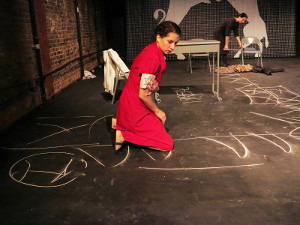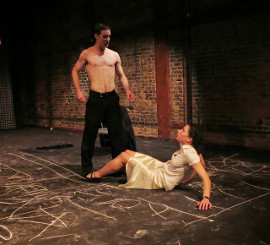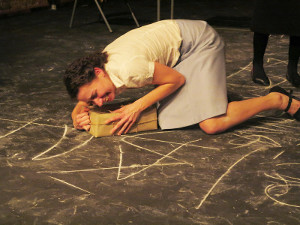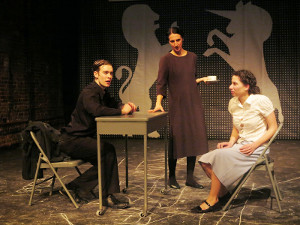|
"King
of Hearts is Off Again"
"King of Hearts is Off Again"
LaMama, Nov. 26-30, 2014
Studium Teatralne, Warsaw Poland
Based on a novel by Hanna Krall
Directed by Piotr Borowski
Featuring: Gianna Benvenuto, Waldemar Chacholski,
Magda Czarny & Danny Kearns.
Music: based on John Zorn motifs
A Kulture+production
Reviewed by Beate Hein Bennett
 |
| Jews
are being rounded up to go to Treblinka. Magdalena Czarny as Izolda.
Photo by Jonathan Slaff. |
Although the Holocaust evokes the unfathomable fate
of millions, it is ultimately the fate of each individual that has
to be considered and imagined. While the mechanism of the Holocaust
in Europe came to a halt in the spring of 1945, the repercussions
continue into our own time with each subsequent generation. The intertwined
perceptions of past and present together with intimations of the future
form our psychic experience and modulate our relationships. Images
of the past flicker and overlay a present moment while the future
beckons with a mirage. Such a view of reality demands a complex dramaturgy
on stage.
Studium Teatralne performed King of Hearts is Off Again as a complex
theatrical narrative with Grotowskian simplicity. Four actors, all
trained in Grotowski technique, filled the small First Floor Theatre
of LaMama with a concentrated explosive narrative of one woman’s
unlikely survival of the Holocaust, tracing her trajectory forward
and backward from the Warsaw Ghetto to old age in Israel. In a non-stop
90 minute highly physical and choreographed performance, two women
played Izolda R. while two men took on multiple characters that affected
her life, her husband, her friends, and her tormentors. Gianna Benvenuto,
as the older Izolda, used her delicately expressive face and ascetic
nimble body to comment on as well as empathize with the actions of
the young Izolda, played by Magda Czarny with tremendous energy and
dynamic expressiveness. Waldemar Chacholski, a mature tall actor with
a wide range of physical expressivity depicted Izolda’s husband
as he is caught in but survives the extermination machinery of Auschwitz
and Mauthausen. Danny Kearns, a young British actor with a dancer’s
control, was the first to appear on stage; with speed of lightning
he chalked on the floor a web of imprisoning spaces as he described
(in English) the walling in of the Warsaw Ghetto and its claustrophobic
conditions.
 |
|
Daniel Kearns and Magdalena Czarny. Photo by Jonathan Slaff. |
The rectangular playing space contained only two
pieces of furniture: a small metal table on coasters and three metal
folding chairs that were moved about according to need and at times
used in a threatening way. A backdrop depicted a rampant lion and
unicorn. (The director explained to me that this heraldic emblem,
originally found in an old Polish synagogue, is in the original production
in Poland painted on the floor, but became a backdrop for the tour
since they could not afford to bring the painted floor.) The lighting
remained mostly neutral during the performance but a sound-scape underscored
the rapidly unfolding events—such as a recurring train sound,
noise, marching boots, fragments of distorted Jewish melodies.
 |
| Izolda
(Magdalena Czarny). Photo by Line Krogh. |
Izolda R.’s narrative is a bizarre jigsaw puzzle
of actions and events that tells of a woman’s passionate efforts
to save her husband from the Nazi death camps. This being her only
reason for her own survival, she determines to hide her Jewishness
by dying her hair “ashblond” and learning to recite the
“Hail Mary” from a Polish girlfriend who also gives her
a small Virgin Mary amulet for good luck and teaches her to move like
a Polish woman. She changes her name from Izolda Regensberg to Maria
Pawlicki and obtains Aryan papers. During a Nazi round-up, she thus
ends up with Polish women in prison rather than being transported
with Jews to Auschwitz. Her husband meanwhile is captured, brought
to Auschwitz where she sends him packages; he escapes, is captured
again and brought to Mauthausen and survives there to the end of the
war, when she finds him. However, like many survivors, he is ultimately
unable to survive his own survival and takes his life.
 |
| L-R:
Danny Kearns, Gianna Benvenuto and Magdalena Czarny. Photo by
Line Krogh. |
The stage action moves non-linear through time and space in which
the Nazi occupation and the Holocaust in Poland, the end of war in
Austria, the post-war period until 1968 in Poland, and lastly Israel
are merged into a continuous present in the mind of Izolda R. Early
in the play, a phrase struck me: “In what language will I tell
my story to my granddaughter?” It is a profound question that
touches on the tragedy of the generational and cultural isolation
experienced by displaced people of all times and places. At the end
of the play Izolda, now old, immobile, and alone in her room in Israel
hears a news item of a bombing in a Jerusalem neighborhood restaurant.
The granddaughter calls her to tell her, “ani beseder”
[I’m o.k.], the only Hebrew phrase that Izolda understands.
The fate of the Jews in Poland during and after World War II is still
a very sensitive subject among Poles who suffered themselves huge
losses during the Nazi and Soviet occupations. It is interesting that
some of the most affecting dramatic treatments of the Polish Jewish
tragedy have come from mostly non-Jewish Polish theatre artists except
for Tadeusz Kantor whose Dead Class incorporates the entire absurd
tragedy of World War II. However, Jerzy Grotowski in the 60s with
Acropolis, and more recently, Tadeusz Slobodzianek with Our Class
(Wilma Theatre, Phila. 2012), and now Studium Teatralne with King
of Hearts Is Off Again under the superb direction of Piotr Borowski
at LaMama show a radical confrontation with this complicated history
in a most profound poetic language of body and soul.
|

